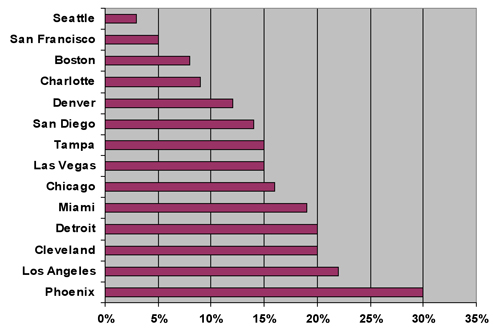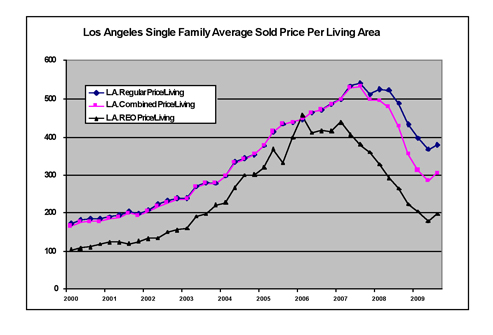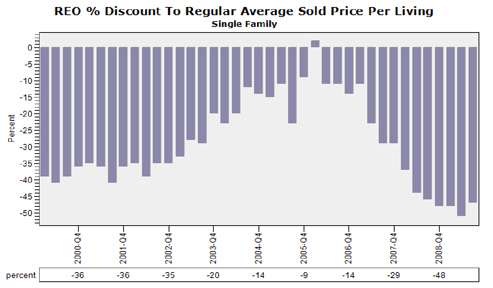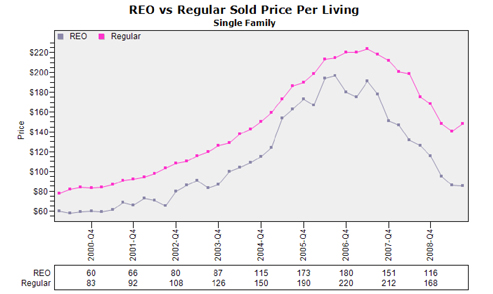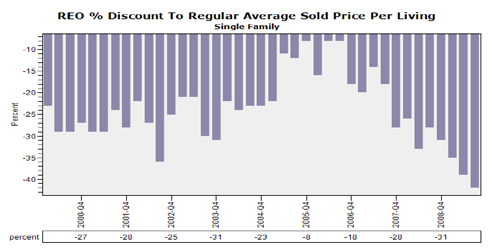By Norm Miller, PhD. and Mike Sklarz, PhD,
Date: Sept 4, 2009
This fall we can expect an increase in the flow of foreclosures. Federal and California moratoriums and the hopes of loan modification have delayed the housing markets move towards normality. So how will this onslaught affect the housing price statistics and in turn the way media will play it?
Some educated consumers know that the REALTOR median house price figures are affected by the mix of homes and thus will move dramatically up or down when higher priced home enter or leave the market. In the short run median prices at the metropolitan level do little to inform homeowners how much their homes may have changed in value over time. Then we have more mysterious indexes produced by famous economists like Robert Shiller and Karl Case or government agencies like OFHEO, now FHFA. Can we rely on them for an indication of what the typical home is worth? Normally they are better than REALTOR median figures for judging price trends, but in recent years with all the distressed sales they too have deviated from reality. More explanation on the various indicators biases of home price trend indicators are provided in the references below. Here the focus is the bias created by distressed home prices which vary from market to market, but which are quite extreme in the current market.
Past research suggests discounts for distressed property sales. See OFHEO (2009) and work by Anthony Pennington-Cross, A. (2006) where the average discount for foreclosures has averaged about 22% in past real estate cycles, but in the recent markets we have witnessed much larger dicsounts. This may be a result of several factors including an increase in predatory lending and the feeling of exploitation by some sellers in foreclosure who have in turn on occasion ransacked their own homes stealing appliances and more as they left the premises.
Data has been analyzed here by Collateral Analytics which separates out the bank REO (real estate owned) post foreclosure sales from the regular (non-distressed sales). It is striking how large some of the discounts are in the current environment. We note in advance that REO sales are concentrated and that the results vary, not only by metropolitan market but by zip code and submarket as well. Here we only show some examples and try to provide some insight into the biases created in typical home price indexes.
Our theory is that we will observe smaller discounts in markets where foreclosures are rare or where they dominant and set market values for the entire market. In between these extremes we will see examples of larger discounts. When we take the price per square foot of living area for regular and foreclosure sales and compare this to only non-distressed regular sales we generate a ratio that suggests the degree of bias in any home price indicator which includes all sales. We are not suggesting that distressed sales don’t affect market values, but we need both types of indexes to really understand what is happening to price trends. In many cities the non-distressed prices are starting to stabilize but our point is that they never went down as much as Case Shiller suggested. See the exhibit below for the ratio of the combined index over the regular only sales prices per square foot. In Seattle and San Francisco the bias is more modest while in Phoenix and LA the bias is much greater. Not only have home owners not gone down in value as much as suggested by commonly reported indexes but they will not be increasing as much as these same indicators suggest as well as the market turns around.
Bias of Residential Price Reports Per Square Foot For the Non-Distressed
Sale when Market Indices Include
REO Sale Using 2009 Data Graph: Collateral Analytics
Data Source: Dataquick and Collateral Analytics.
Further examples are show below. First we see the annual trend in terms of discounts for Los Angeles. Shown in the graph below are three figures, the top line showing sales prices per square foot of living area for regular sales. The lowest line are distressed sales and the combined line shows all sales which comes closer to the kind of results shown by Case Shiller. Prior to 2008 the typical discounts averaged 22% (A. Pennington Cross, 2006) and there were few foreclosures but in 2009 the difference is much higher, closer to 40% and on an absolute dollar basis implies more than a $180 dollar difference in price per square foot. We next show the regular versus REO sales alone and calculate the differences in the graph below.
In the following graph for Miami we see an upturn in the regular sales prices per square foot, perhaps aided by the Federal stimulus funds, but the gap between distressed sales and non distressed sales has widened. The discounts are very significant running just under 50% in recent months for REO sales when compared to the results for regular sales at the CBSA level. Certainly within distressed neighborhoods these spreads will be less than shown here as the contagion effect dominates within high foreclosure neighborhoods. Still, at the CBSA level we can see how the combined Case Shiller style indexes are very misleading when applied to all homes. For a file containing more details on several cities please contact us and we will be pleased to send more examples.
Los Angeles Single Family Regular and REO and Combined Average
Sold Price Per Living Area
Los Angels CBSA CA Regular Sale & C-S NAR Price Indexes
 Source: DataQuick, Case Shiller and Collateral Analytics (CA above)
Source: DataQuick, Case Shiller and Collateral Analytics (CA above)
Los Angels Single Family Regular and REO Average Sold Price
Pre Living Area
Los Angels Single Family Average Price Per Living Area LEO to
Regular Sale Percent Discount
Miami Single Family Regular and REO Average Sold Price
Pre Living Area
Miami Single Family Average Price Pre Living Area REO to Regular
Sale Percent Discount
